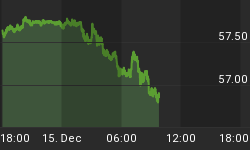The period between December expiry and the year end offered an opportunity to review your overall trading approach. The second half of 2010 presented a remarkable advancement in equities markets, and nearly the entire period was punctuated with opinions and forecasts saying the market couldn't go much higher. Looking back, did you trade with a bullish bias or with a bearish bias over the last six months? Was it difficult to "buy the dip" each time, because you thought the upward trend must be near its end?
For swing traders and day traders alike, it is crucial to your trading success to be able to assess the actual trend relevant to the timeframe you are trading. A bias in direction on the daily timeframe can be just as detrimental as a bias about the big picture. Paradoxically, your bias may be correct - the market might be destined to fall as all of your instincts say it should - but the mere presence of the bias will cause you to make poor trading decisions that are rooted more in your beliefs than in the actual information the market presents to you in the moment.
At Trading da Numbas [www.tradingdanumbas.com], we strive to present unbiased analysis of the markets and to show traders how to identify and act on the high-probability opportunities that a bias would otherwise cause them to overlook.
If you correctly traded the past six months of mostly higher highs and higher lows as a bullish trend, then the December expiry was a happy and a profitable one for you. On the other hand, if your bias and trading were based on bearish expectations, then with the exception of two periods consisting of a two-week window in August and a week in November, the expiry was a less rewarding one.
The attached chart shows the price of S&P 500 futures contracts (ES) from the start of July through the end of the December expiry based on the ES December contract. The period prior to the December contract becoming the active contract has been adjusted with the spread at the rollover date.
The entire period from the July low to most recent bar shown for December consisted of 166 days with five discernible swings. (The last swing is not necessarily completed, but may seem curtailed a due to expiry and the use of the December contact in this presentation.) Each day on the chart is made up of five bars of the regular-hours session.

-
The first period took 39 days to produce 120.75 points within 133 bars (i.e., 3 points per day & less than 1 point per bar). This move up recovered just over 50% of the fall from the April highs to the July lows.
-
The retracement of the first period formed the second period. A 16-day retracement recovered almost 90 points within 56 bars (i.e., 5.6 points per day and about 1.6 points per bar). The retracement consisted of a 1:1 move lower and covered slightly more than 70% of the prior period.
-
The third period was the resumption in trend in the direction of the first period. For bears, the failure of price to move decisively below 1,047, followed by an energetic overnight jump over 1,056 - our "line in the sand" - were strong warnings that the probable direction was upward. (The levels mentioned here were provided to TdN subscribers in end-of-day commentary and intraday chatroom guidance. In addition, it was important to note that on September 1, the energetic move took price back above the 50% retracement level of the initial upward move mentioned earlier.) In fact, the failure of the market to retrace any of the price action of September 1, and the upward direction of subsequent days, suggested the market intended to move beyond the August highs and perhaps as far as the 61.8% retracement of the range from the April high to the July low. After exceeding even those levels, the market continued into the 1:1 at 1,153 and, following a small consolidation, moved into the 1:1.618 area near 1,227.50. The actual high fell just 3 points short of this level. In addition, the duration of the entire third swing lasted almost twice as long as the first upward swing in terms of trading days, taking 76 days to produce 192.50 points within 265 bars (approximately 2.5 points per day and less than 1 point per bar -- not as rapid, but more steady than the first upward swing). During this period we pointed out to TdN subscribers that the largest retracement within the entire third period was not more than 26.75 points.
-
The fourth period, a seven-day retracement, recovered almost 54 points within 29 bars. (See the extended version of this article at TdN for a more detailed analysis of the fourth period and why it should not have been seen at the time as a larger change in trend.)
-
The fifth period continued past December expiry and through year-end. (See the extended version of this article for a more detailed analysis.)
At the TdN website, we have posted a more detailed examination [http://tradingdanumbas.com/community/misc.php?do=form&fid=6] of each of the market swings described above, along with some guidelines for the number of ES points that could reasonably have been extracted from the market with the correct swing-trading approach. The extended analysis is available free to anybody who creates a username and password at TdN.

















